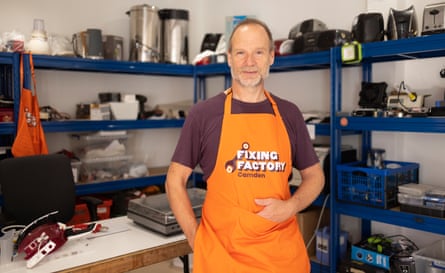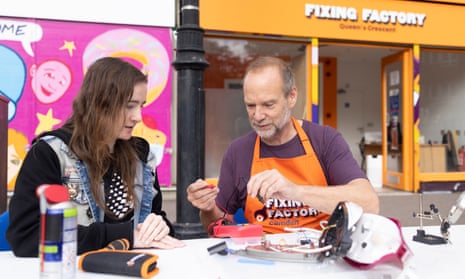The Lonely Parts Club sits in a plastic box just along from a couple of tired-looking tea urns, a slick inkjet printer and a line of “rescue toasters”. The motley collection of technology is neatly stacked on the shelves of the Fixing Factory, where volunteers in bright orange aprons chat to people seeking to give their gadgets a second life.
The small shop in Camden, north London, which opened officially last month after operating in “stealth mode” without publicity since September, is at the forefront of a revolution in consumption.
While there has always been a market for restoring antiques – given a recent fillip by the hit BBC show The Repair Shop and its cameo by King Charles – and most urban high streets have a place that repairs expensive items such as mobile phones, computers and appliances, a new wave of fixers are setting their sights on salvaging cheaper, everyday items such as radios and juicers.
Share & Repair in Bath, the Edinburgh Remakery and Re:Make Newport are just some of the establishments springing up across the country working to prevent electronic waste, or e-waste, from entering landfill. In Wales, the government is helping fund a scheme that aims to open repair cafes in every community.
“E-waste is the fastest growing waste stream in the world and we need local solutions,” says Dermot Jones, who is a project manager of the Fixing Factory for the climate charity Possible and is also involved in pop-up repair events in Tooting, south London.
“We are facing a consumer goods crisis … we have become used, over the past 40 years, to buying something that can’t be fixed and we accept that as a kind of trade-off for it being cheap.”

Part of the Fixing Factory’s plan is to show those who bring along an item that they may be able to easily repair it themselves. Jones says it is often a myth that it takes longer and costs more to fix an item than to buy a new one. “We are inspiring and surprising people that some things are very easily fixable,” he says.
The enterprise, which is funded by the National Lottery Climate Action Fund and the Centre for Climate Change and Social Transformations, has trained up 11 young people and a number of other local volunteers. One joy is finding local experts, for example, an 85-year-old former BBC engineer, who are adapting their years of technological knowhow to work out how to get into and then fix modern gadgets.
Jones says the project has had a 90% success rate in mending easier items such as toasters and other small kitchen appliances but has had less success with laptops – fixing about 60%. He has just fixed a digital radio worth more than £100 with a 10p part.
Bath’s Share & Repair says it has repaired more than 3,000 items in the five years since it opened, 60% are electrical or electronic items, mainly kettles, toasters, radios and lamps. The project also lends out household items and runs workshops on how to maintain your bicycle, use a sewing machine or darn a jumper.
Such outlets reflect a booming global network of fixing fans sharing knowledge via YouTube videos, pop-up repair cafes and blogs, and a long British tradition of reusing old items that stretches back to the second world war directive to “make do and mend”.
Currys, the UK’s biggest electrical goods retailer, expects the cost of living crisis to further accelerate the trend. It typically carries out 860,000 fixes a year on laptops, TVs and phones but forecasts a 10% rise this year as customers’ budgets come under pressure. Demand is also increasing for its refurbished electrical goods, which it is testing out selling from its own website for the first time.
However, one of the biggest hurdles to the mending movement is the fact much of modern technology isn’t designed to be fixed. The leading online repair resource iFixit gives reviews of how repairable gadgets are – criticising, for example, Apple for its AirPods, which are constructed in such a way that it is not even possible to replace the battery.
Often parts are not made available, or are costly, and cases may be sealed shut or the screws to open them are only accessible with strangely shaped tools that are not available in your local hardware store.
“It’s like an escape room in reverse,” Jones says. “On an old record player you find arrows on the bottom of the case pointing at where to get in. Now those screws can be covered with a sticker or rubber feet or it may be closed with a system of plastic clips that can break. It’s a challenge getting in sometimes.”

The time and ingenuity required to get into and assess a broken toaster, for example, means that, once labour costs are taken into account, fixing it does not make economic sense. The solution, for now, is teaching people how to fix more things themselves and using volunteers.
Jones says training up young people could be vital for the future economy as an army of experts may be required after the introduction of legislation that makes it easier and more cost-effective to fix things.
Manufacturers of phones, tablets and laptops now face legal obligations to make their products easier to repair and reuse, under an EU recycling plan to lengthen the life of products, with only 40% of electronic waste in the zone thought to be recycled.
The UK government’s version of these rules – the right to repair regulations, which apply to products bought from July 2021 onwards but will not come into full effect until next summer – cover only a limited selection of household electricals, including washing machines, dishwashers, refrigerators, and televisions.
Under the regulations, manufacturers are obliged to produce spare parts for a minimum period of seven to 10 years and enable repairs to be made using “commonly available tools”. They must also make maintenance and repair information available to professional fixers.
The UK regulations do not cover smaller items such as laptops, mobile phones, electric toothbrushes, headphones, phone chargers or toasters. Some manufacturers are even making it harder to source spare parts – only selling them as part of expensive kits rather than individually.
While campaigners say the regulations are too weak to really boost the market, they are hoping the growing British passion for repair will override government inaction and encourage the public to lengthen the life of their belongings.
